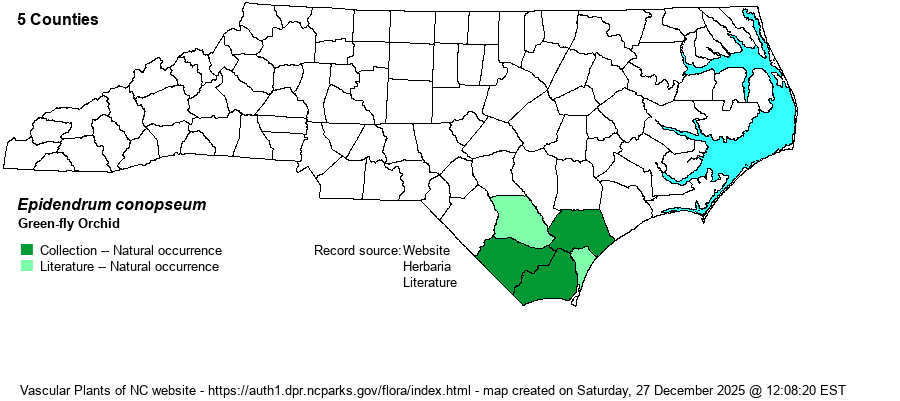| Author | W.T. Aiton | |
| Distribution | Limited to the extreme southeastern counties: Bladen, Pender, New Hanover, Brunswick, and Columbus. It is considered to be extant (fairly recent records) in all five counties.
This species ranges north only to southeastern NC, and then south to southern FL and LA. It is limited to just the southern halves of the Atlantic and Gulf Coastal Plain regions. Also disjunct to northeastern Mex.
| |
| Abundance | Rare and easily overlooked, owing to it occurring only on branches well above ground; binoculars may be needed to spot the plants. It is a State Threatened species. | |
| Habitat | This species essentially grows on the upper sides of horizontal limbs of trees found in blackwater swamps, more often on limbs of Bald Cypress (Taxodium distichum), but also on limbs of tupelos (Nyssa spp.). It can, at times, be found on trees growing in other moist hardwood forests, such as mainland maritime forests, though this habitat is used mostly south of NC. In the state, it often grows with Resurrection Fern (Pleopeltis michauxiana). | |
| Phenology | Flowers from July to November, and fruits shortly after blooming. | |
| Identification | This is the only epiphytic orchid in NC, though there are many farther south; only a few other vascular plants are epiphytes in the state, most notably American Mistletoe (Phoradendron leucarpum) [actually a parasite on tree limbs], Spanish-moss (Tillandsia usneoides), and Resurrection Fern. This orchid is evergreen, with thick and leathery narrowly lanceolate, dark green leaves; leaves average only 1-3 per plant. Each leaf is roughly only 2-3 inches long but less than 1/2-inch wide, making plants relatively small on a limb, often mixed with the fern. When in bloom, they are much easier to spot. The flowering stem can be about 6 inches long to at times longer, with a handful of pale green (spider-like) flowers, each about 1 inch across. The flower cluster often droops downward, in which case the species should be much easier to find than simply attempting to locate plants by its leaves only. Observers planning to search for the species may need to be in a canoe and may need to have binoculars with them, as well! | |
| Taxonomic Comments | The species was known as Epidendrum conopseum in much of the 20th Century (i.e., in RAB 1968). A few references use E. magnoliae, but most keep it as E. conopseum.
| |
| Other Common Name(s) | None, other than different usages (or not) of the hyphen, such as Green Fly Orchid. | |
| State Rank | S1S2 | |
| Global Rank | G4 | |
| State Status | T | |
| US Status | | |
| USACE-agcp | | |
| USACE-emp | | |

